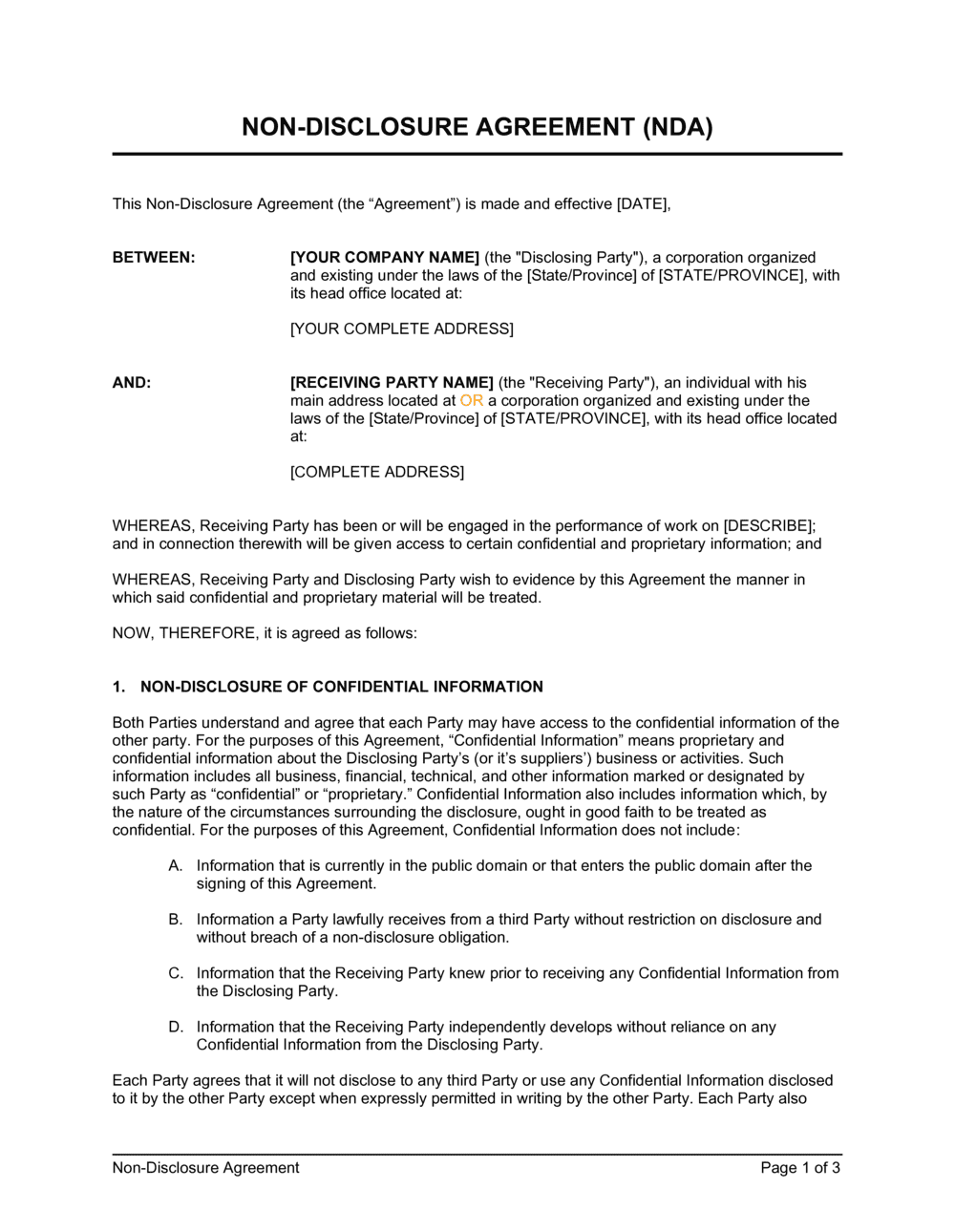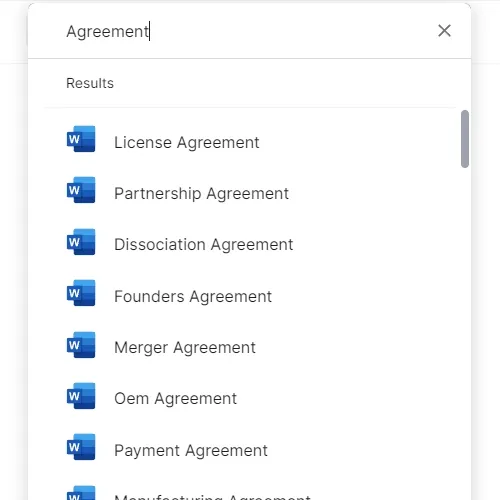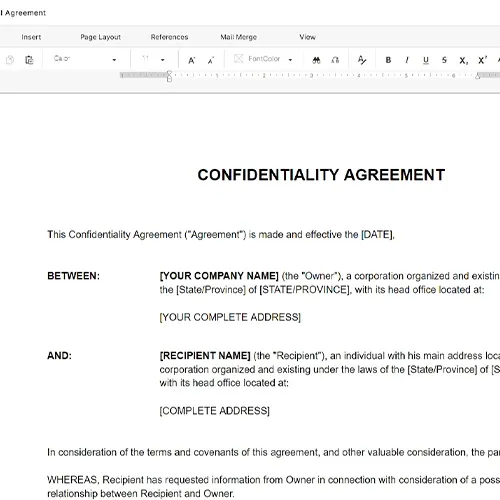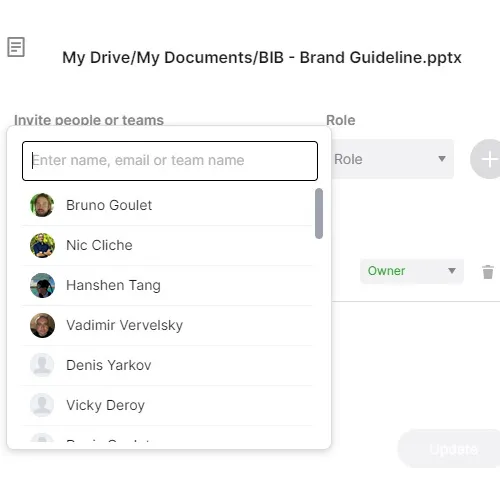Non Disclosure Agreement Nda Template

Introduction
A Non Disclosure Agreement is a legal contract designed to protect sensitive information. It establishes confidentiality obligations between parties, clearly defining what must remain private, how it may be used, and what happens if there's a breach.
When to Use an NDA
Use this document whenever you're sharing business plans, intellectual property, trade secrets, or other proprietary data with employees, contractors, investors, partners, or vendors. NDAs help preserve trust, protect competitive advantage, and avoid misunderstandings.
Types of NDAs
- Unilateral (One Way): Only one party discloses confidential information, and the recipient is bound to secrecy.
- Mutual (Bilateral): Both parties exchange sensitive data and agree to protect each other’s disclosures.
- Multilateral: Involves three or more parties sharing confidential information among themselves.
Key Clauses to Include
| Clause | Purpose |
|---|---|
| Parties & Effective Date | Clearly identify the Disclosing and Receiving parties and the date the agreement begins. |
| Definition of Confidential Information | Describe what’s protected—written, verbal, digital, or visual—without being overly broad. |
| Exclusions | Explicitly exempt information that’s public, previously known, independently developed, or lawfully obtained. |
| Obligations of Receiving Party | Restrict copying, sharing, or using the information beyond permitted purposes. Include responsibilities for third parties or associates. |
| Duration | Set a timeframe—commonly 2–5 years, depending on the nature of the information. Trade secrets may warrant longer terms. |
| Return or Destruction of Information | Require the return or deletion of confidential materials at the agreement’s end or on demand. |
| Remedies & Dispute Resolution | Establish consequences for breaches—potential arbitration or legal action rather than court litigation. |
| Governing Law & Jurisdiction | Specify which state or country laws apply. |
Customization Tips & Best Practices
- Tailor for the Situation: Refer to the correct NDA type—contractor, employee, investor, or real estate—based on how information is shared.
- Avoid Unnecessary Complexity: Use clear, precise language. Courts may reject overly broad or vague definitions.
- Ensure Readability: Break content into bullet points, tables, or clear headings to make it user-friendly. This also helps SEO by reducing keyword stuffing.
- Update Regularly: Review your template periodically to include new protections or aligned with current legal requirements.
Why Use This Template
- Clarity and Legal Precision: Covers essential elements without unnecessary jargon.
- Customizable for a wide range of situations—from startups to enterprise projects.
- SEO friendly structure: Balanced keyword usage, helpful organization, and focused headings make it accessible to users and search engines alike.
Extra Tips for Effective Use:
- Before sharing any confidential information, ensure all parties have signed the NDA.
- Keep a signed copy stored securely, accessible for any potential enforcement.
- When in doubt—especially for high-stakes scenarios—consult a legal professional.
Updated in July 2025
Reviewed on

Introduction
A Non Disclosure Agreement is a legal contract designed to protect sensitive information. It establishes confidentiality obligations between parties, clearly defining what must remain private, how it may be used, and what happens if there's a breach.
When to Use an NDA
Use this document whenever you're sharing business plans, intellectual property, trade secrets, or other proprietary data with employees, contractors, investors, partners, or vendors. NDAs help preserve trust, protect competitive advantage, and avoid misunderstandings.
Types of NDAs
- Unilateral (One Way): Only one party discloses confidential information, and the recipient is bound to secrecy.
- Mutual (Bilateral): Both parties exchange sensitive data and agree to protect each other’s disclosures.
- Multilateral: Involves three or more parties sharing confidential information among themselves.
Key Clauses to Include
| Clause | Purpose |
|---|---|
| Parties & Effective Date | Clearly identify the Disclosing and Receiving parties and the date the agreement begins. |
| Definition of Confidential Information | Describe what’s protected—written, verbal, digital, or visual—without being overly broad. |
| Exclusions | Explicitly exempt information that’s public, previously known, independently developed, or lawfully obtained. |
| Obligations of Receiving Party | Restrict copying, sharing, or using the information beyond permitted purposes. Include responsibilities for third parties or associates. |
| Duration | Set a timeframe—commonly 2–5 years, depending on the nature of the information. Trade secrets may warrant longer terms. |
| Return or Destruction of Information | Require the return or deletion of confidential materials at the agreement’s end or on demand. |
| Remedies & Dispute Resolution | Establish consequences for breaches—potential arbitration or legal action rather than court litigation. |
| Governing Law & Jurisdiction | Specify which state or country laws apply. |
Customization Tips & Best Practices
- Tailor for the Situation: Refer to the correct NDA type—contractor, employee, investor, or real estate—based on how information is shared.
- Avoid Unnecessary Complexity: Use clear, precise language. Courts may reject overly broad or vague definitions.
- Ensure Readability: Break content into bullet points, tables, or clear headings to make it user-friendly. This also helps SEO by reducing keyword stuffing.
- Update Regularly: Review your template periodically to include new protections or aligned with current legal requirements.
Why Use This Template
- Clarity and Legal Precision: Covers essential elements without unnecessary jargon.
- Customizable for a wide range of situations—from startups to enterprise projects.
- SEO friendly structure: Balanced keyword usage, helpful organization, and focused headings make it accessible to users and search engines alike.
Extra Tips for Effective Use:
- Before sharing any confidential information, ensure all parties have signed the NDA.
- Keep a signed copy stored securely, accessible for any potential enforcement.
- When in doubt—especially for high-stakes scenarios—consult a legal professional.
Updated in July 2025
Easily Create Any Business Document You Need in Minutes.

Download or open template
Access over 3,000+ business and legal templates for any business task, project or initiative.

Edit and fill in the blanks
Customize your ready-made business document template and save it in the cloud.

Save, Share, Export, or Sign
Share your files and folders with your team. Create a space of seamless collaboration.


